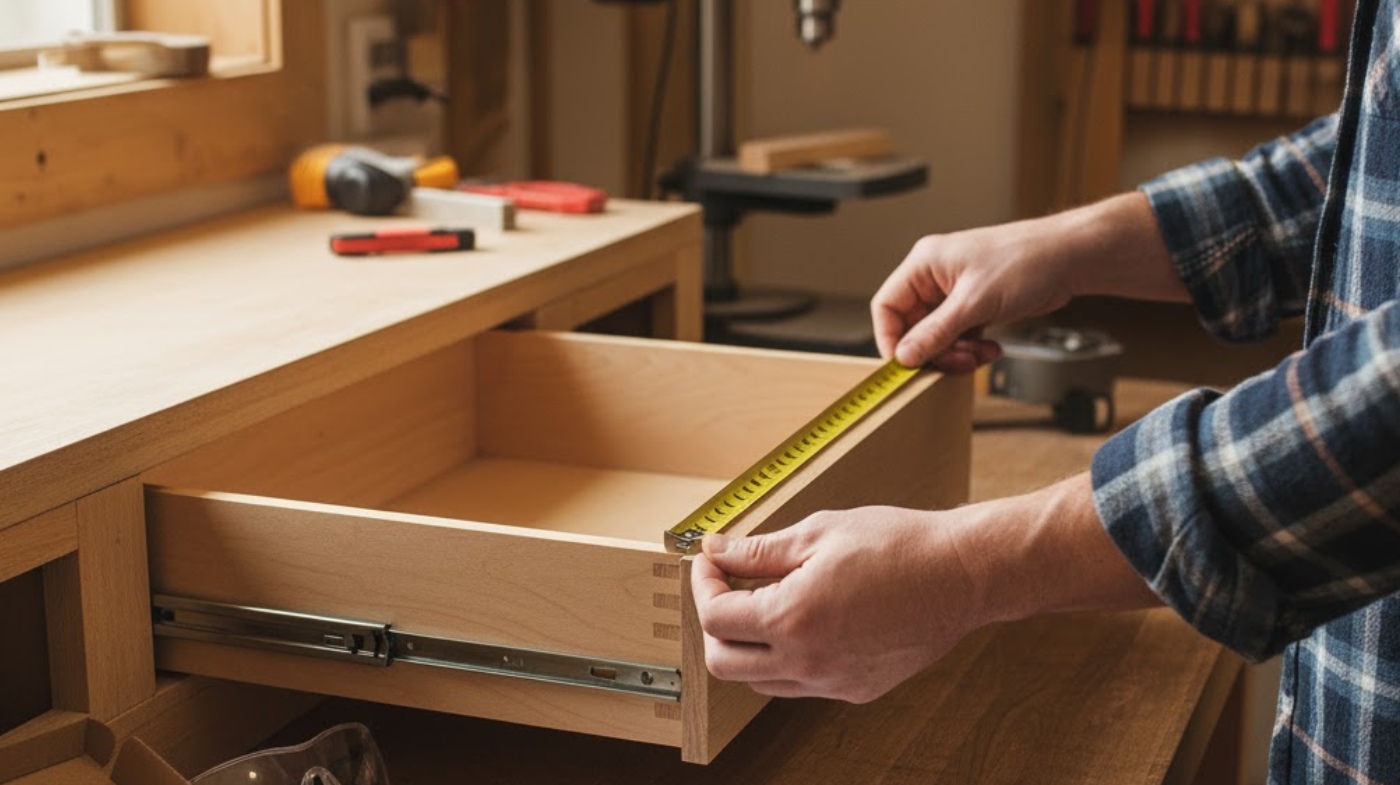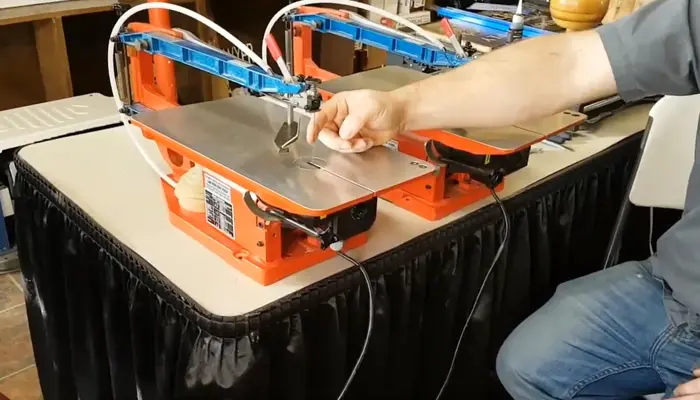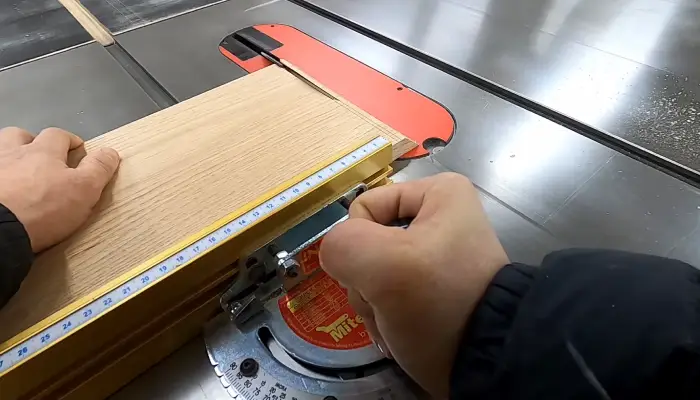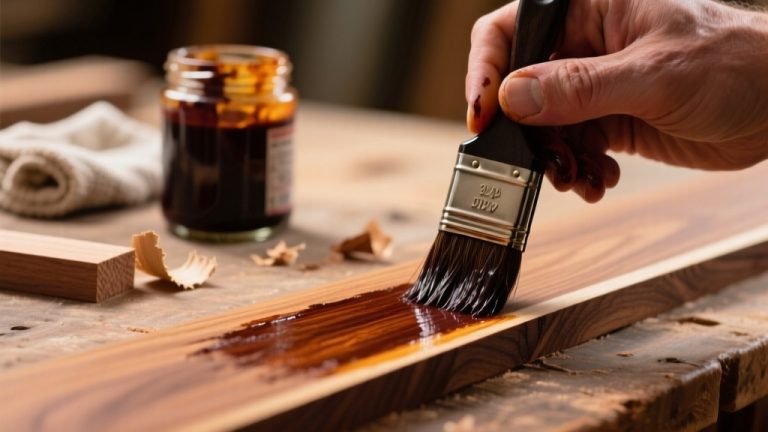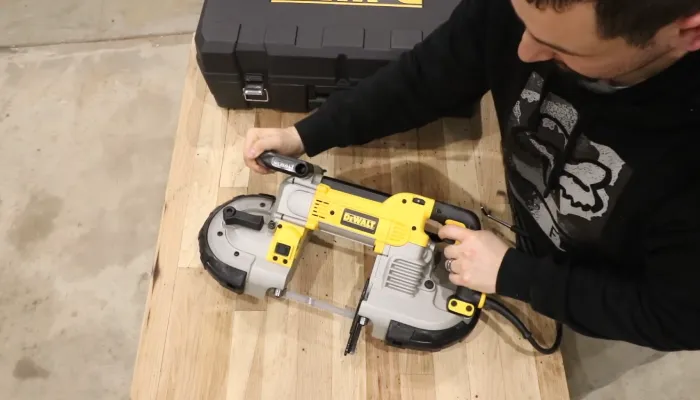How to Measure for Drawer Slides? Step-by-Step Guide
To measure for drawer slides, first remove the drawer and measure its length from back to front edge, excluding the drawer front.
Measure the inside cabinet width precisely to 1/16 inch to calculate drawer width, subtracting twice the slide clearance and drawer side thickness.
Note the cabinet’s depth and height for slide compatibility. Consider the slide type, side or undermount, as it affects clearance and setback.
Tools like adjustable squares help guarantee accuracy. Understanding these basics sets you up for proper fitting and smooth operation.
Key Takeaways
- Remove the drawer completely and measure its length from back to front edge, excluding the drawer front panel.
- Measure the inside width of the cabinet opening precisely to 1/16 inch for accurate drawer width calculation.
- Subtract twice the clearance space and twice the drawer side thickness from the cabinet opening width to determine drawer box width.
- Round drawer length measurement down to the nearest standard slide length in 2” (side-mount) or 3” (undermount) increments.
- Consult manufacturer specifications for setback, clearance, mounting hole positions, and slide type requirements before ordering slides.
Measuring the Length of Your Drawer
To measure the length of your drawer accurately, start by removing the drawer completely along with its slides.
Different slide types require specific removal methods: rollers lift up, side-mount slides have release levers, and undermount slides use clips at the bottom corners. Fully extended drawers facilitate safe removal and allow better access to the adjustable bevel mechanism if present.
Fully extend the drawer to facilitate safe removal. Set the slides aside for reference.
Measure the external length of the drawer box from its back to the front edge, excluding the drawer front panel. This ensures your measurement reflects the box size, not the attached hardware.
Standard slide lengths typically range from 9” to 30”, so rounding down your measurement to the nearest standard length in 2” increments for side-mount slides and 3” for undermount ensures compatibility.
Accurate length measurement guarantees proper fit, clearance, and smooth drawer operation within the cabinet.
Determining the Width and Cabinet Opening
To get started, measure the inside width of your cabinet opening right between the stiles at the face frame. It’s really important to be precise here! Be sure to measure the cabinet width to the nearest 1/16 inch for the most accurate results accurate measurements. Using precision tools designed for woodworking can help ensure these measurements are exact.
Once you have that measurement, you’ll want to think about the clearance space you need. This will depend on the type of slides you’re using. Ensuring there’s enough clearance is key for smooth drawer movement and avoiding binding caused by improper kerf thickness allowance.
After you’ve figured out the clearance, it’s time for a little math! Take the cabinet opening width and subtract twice the clearance space along with the thickness of the drawer sides.
This will give you the right width for your drawer box. It might sound a bit complicated, but just take it step by step, and you’ll get it right!
Measuring Drawer Width
When measuring drawer width, you need to subtract the necessary clearance from the cabinet opening to ensure smooth slide operation and prevent binding.
For side-mount slides, deduct 3/8″ total, 3/16″ per side, to allow proper clearance.
With undermount slides, subtract about 5/8″ to accommodate hardware thickness.
Next, factor in the drawer side thickness, typically 5/8″ for undermount slides, subtracting it twice from the internal opening to ensure accurate internal drawer width.
This internal width directly affects usable storage space and must match slide specifications to avoid fit issues.
Measure the cabinet opening precisely, then subtract the total clearance and side thickness to determine the drawer width.
This method guarantees compatibility, smooth slide function, and ideal storage capacity.
Additionally, understanding that side thickness impacts the internal gap is critical, as thicker sides require less clearance to fit properly within the cabinet opening, ensuring optimal drawer fit.
Choosing the appropriate slide type depends on factors like load capacity and precision, similar to how tooth design affects saw performance in woodworking.
Cabinet Opening Size
Accurately measuring the cabinet opening size establishes the foundation for determining the correct drawer dimensions and slide compatibility.
Start by measuring the opening’s width, accounting for door thickness and hardware clearance. Usually add 1 to 1.5 inches total to prevent binding. Proper alignment capabilities ensure smooth operation and reduce wear on the slides.
Base cabinet widths range from 9 to 48 inches; tall cabinets typically span 12 to 36 inches.
For height, measure from the floor or countertop underside to the cabinet’s bottom frame. Consider that standard base cabinet heights are typically 34.5 inches without the countertop.
Depth varies by cabinet type; base cabinets usually 24 inches deep, wall cabinets 12 to 15 inches.
Remember to include side panel thickness and any filler pieces in your measurements to guarantee proper slide placement and smooth drawer operation.
Calculating Clearance Space
Although measuring the cabinet opening width might seem straightforward, calculating the correct clearance space is essential to guarantee your drawer slides operate smoothly without binding.
Clearance is the gap between the drawer box and cabinet opening, ensuring frictionless motion. For side-mount slides, allocate ¼” clearance per side; undermount slides need about 5/16” per side. Before measuring, it is important to remove the drawer from the cabinet to get accurate measurements of both the drawer and the cabinet interior. Using tools that generate less dust and debris can help maintain accuracy and cleanliness during the measuring and cutting process.
Subtract twice the side clearance from the inside cabinet width to determine the drawer box width. Always verify measurements before cutting or ordering.
| Slide Type | Clearance per Side | Total Clearance | Cabinet Opening | Drawer Box Width Calculation |
|---|---|---|---|---|
| Side-Mount | ¼” (6mm) | ½” (12mm) | 20” | 20” – ½” = 19.5” |
| Undermount | 5/16” (8mm) | 5/8” (16mm) | 15.75” | 15.75” – 5/8” = 15.125” |
Understanding Different Drawer Slide Types
How do you choose the right drawer slide for your project? Start by considering slide mechanisms: roller slides suit light loads with about ¾ extension; ball-bearing slides handle medium to heavy loads smoothly. Roller slides typically provide three-quarters extension, which is sufficient for many applications. For projects requiring precise and smooth operation, consider features similar to those found in high-precision machinery such as Powermatic PM2000T.
Push-to-open slides enable handle-free access; soft-close slides prevent slamming; self-close slides finish closing automatically.
Next, pick mounting styles: side-mounts are common and economical; bottom-mounts increase stability. Side-mount slides are generally easier to install and remain visible when the drawer is open. Undermounts offer a clean look and smooth motion; center-mounts simplify installation but hold less weight. Top-mounts fit where others won’t.
Extension types matter too—full-extension grants complete access, while three-quarter or partial extensions save space.
Finally, factor in functional features like locking or soft-close to match your use case. Matching these variables guarantees ideal drawer performance and durability.
Accounting for Setback and Clearance Requirements
When you’re working on installing drawer slides, it’s super important to get the setback just right. This is the distance from the front of the cabinet to where the slide actually starts. If you don’t measure this carefully, it could throw off the alignment of your drawers. Using precise marking tools like a carpenter pencil can help ensure accuracy.
And don’t forget about clearance space! You need to leave some room on each side of the slide. This helps to prevent any binding and makes sure everything operates smoothly. Regular closed slides typically require about 0.5-inch clearance per side to function properly.
It’s always a good idea to check the manufacturer’s specs for your specific slide type, as they’ll have the precise measurements you need for both setback and clearance.
Slide Setback Basics
When installing drawer slides, accounting for setback is essential to guarantee the drawer front clears the cabinet face smoothly without binding.
Setback is the distance the slide is positioned inward from the drawer front edge, typically calculated as the drawer front thickness plus about 3/16″ (5mm).
You measure setback from the drawer or cabinet front edge to the centerline of the slide’s screw holes.
Precise setback ensures proper slide function, drawer alignment, and aesthetics. Using tools with precision ground teeth can similarly ensure accuracy in cabinetry work.
Use an adjustable square to mark setback before drilling, applying it consistently on both sides for square installation.
Remember, slide type and drawer side thickness influence setback dimensions, so consult manufacturer charts when available.
Maintaining accurate setback prevents drawer rubbing and guarantees smooth, balanced slide engagement.
Additionally, when determining setback, it is important to measure the available cabinet space carefully, subtracting allowances for clearance and inset fronts to calculate the correct slide length and position measuring cabinet space.
Clearance Space Needs
Accurately setting the slide setback lays the foundation for proper slide function.
However, ensuring adequate clearance space around the drawer is just as important to prevent binding and wear. Proper tool setup can help achieve precise measurements and avoid alignment issues.
For side-mount slides, maintain about 1/2 inch clearance per side inside the cabinet, totaling 1 inch. This prevents scraping and misalignment that cause premature slide failure. It is also important to measure the drawer length precisely to select the correct slide size that fits these clearances.
Vertically, allow at least 1/8 inch clearance from top and bottom to avoid binding and vibration, ensuring smooth glide.
Depth clearance must accommodate slide length plus setback, allowing full extension without obstruction.
Soft-close mechanisms need extra space for hardware bulk to function quietly and smoothly.
Strictly adhere to these clearance requirements to maintain slide durability, drawer stability, and ideal performance.
Manufacturer Specifications
Several manufacturers provide detailed specifications that are essential for correctly accounting for setback and clearance requirements during drawer slide installation.
Setback, the distance from the drawer front to the slide front, varies by slide type and brand. You must consult technical sheets before installation. Understanding the impact of wear on moving parts can help maintain smooth operation over time.
For example, side-mount slides often require a 0.5″ setback, but undermount designs differ.
When reviewing manufacturer specs, focus on:
- Exact setback measurements and mounting hole positions to ensure proper drawer face alignment.
- Required side and vertical clearances for smooth slide operation and load capacity adherence.
- Slide dimensions and load ratings to match your drawer size and expected use. In addition, consider the load capacity to ensure the slides can support the drawer contents without sagging or failure.
Following these guidelines guarantees precise fit and function according to manufacturer standards.
Preparing Your Drawer and Tools for Accurate Measurement
Before measuring your drawer slides, you need to prepare the drawer and gather the right tools to guarantee precise results.
Empty the drawer and remove it completely, using a screwdriver if needed to detach screws or wheels. Place the drawer on a flat, stable surface. Clear any obstructions like liners or hardware that may skew measurements. It is important to measure the box, not the drawer front to ensure accurate sizing of your slides.
Prepare a well-lit workspace to guarantee accuracy.
| Tool | Purpose |
|---|---|
| Tape Measure | Measure length & width |
| Screwdriver | Remove screws or hardware |
| Clamp (optional) | Aid installation (not measuring) |
| Notepad/Digital | Record measurements promptly |
Ensure your tools are ready, and your drawer is accessible before proceeding to measure precisely.
Measuring Drawer Height and Cabinet Interior Depth
With your drawer removed and tools ready, start by measuring the drawer height and the cabinet’s interior depth to guarantee proper slide fit.
Measure the vertical distance inside the cabinet from the bottom of the drawer opening to the top edge, noting variations left, center, and right.
Then, measure the interior depth from the back wall to the inside front edge, checking top, middle, and bottom for consistency. Most base cabinets typically have an interior depth of about 24 inches, which serves as a useful reference point when measuring.
- Measure drawer height precisely, accounting for drawer front thickness and possible slanting.
- Measure cabinet interior depth accurately, excluding door and countertop thickness.
- Use these dimensions to select drawer slides 1-2 inches shorter than the interior depth to avoid binding or incomplete closure.
Tips for Avoiding Common Measurement Errors
Although measuring drawer slides might seem straightforward, small errors can lead to poor fit and operational issues. Always remove the drawer before measuring length, width, and clearance to avoid misalignment.
Measure both sides and ends of the drawer and cabinet to catch dimensional variances. Use a properly aligned tape measure, avoiding angles that distort length.
Round down measurements to the nearest standard slide size to ensure hardware availability. Add 2-3 millimeters clearance to accommodate slide thickness and mechanisms like soft-close.
Double-check all measurements independently before ordering or modifying. Follow the manufacturer’s specifications precisely, including setback and clearance requirements.
Employ precise tools and maintain squareness and parallelism to prevent binding or uneven drawer movement. These steps minimize errors and ensure smooth installation and operation.
Additionally, consider the mounting style of your slides—such as side-mount or undermount—as this affects clearance and measurement requirements.
Choosing the Right Slide Extension Type
When selecting drawer slides, you’ll need to contemplate the extension type to match your access requirements and installation constraints.
The extension determines how far the drawer opens, impacting accessibility and function. Choose wisely to maximize usability.
- Partial Extension: Opens about 75%, ideal for limited access where full visibility isn’t necessary. Simple, cost-effective, and often used in residential cabinetry. These slides are commonly found in light-duty applications such as kitchen and office drawers.
- Full Extension: Opens 100%, providing complete access to drawer contents. Suitable for kitchens, offices, and tool storage requiring full visibility.
- Overtravel Extension: Exceeds 100% travel for deep drawers or specialized needs, such as lab trays or industrial applications, offering maximum reach beyond the cabinet front.
Frequently Asked Questions
Can I Use the Same Drawer Slides for Kitchen and Bathroom Drawers?
Yes, you can use the same drawer slides for both kitchen and bathroom drawers if they meet your weight and size requirements.
Choose medium-duty slides with corrosion-resistant finishes for bathrooms to handle moisture.
Soft-close or ball bearing slides work well in both spaces for smooth operation.
Just verify the slide type matches your cabinet style and drawer dimensions to guarantee proper fit and functionality in either environment.
How Do I Measure for Drawer Slides on Custom or Irregularly Shaped Drawers?
Measuring custom drawers is like fitting a key to a unique lock; you need exactness.
Start by removing the drawer entirely. Then measure its widest, tallest, and deepest points inside the box, not the front or opening.
Record these dimensions separately. Make certain mounting surfaces are flat and parallel.
Choose slides that fit the rounded-down depth and account for weight. Always allow 1/8–1/4 inch clearance for smooth operation and verify fit before installation.
What Tools Besides a Tape Measure Can Improve Measurement Accuracy?
You can enhance measurement accuracy using calipers for precise thickness and groove widths, and combination squares to verify 90-degree angles.
Steel rulers provide straight edges for scribing, while digital laser distance measurers capture quick, accurate distances in tight spots.
For alignment, spirit levels and T-squares help maintain horizontals and right angles.
Clamps with measurement guides reduce movement, and marking gauges ensure consistent screw hole placements, all boosting your precision beyond a tape measure.
Are There Drawer Slides Specifically Designed for Heavy or Oversized Drawers?
Yes, you’ll find drawer slides specifically engineered for heavy or oversized drawers.
These heavy-duty slides, like Vention’s telescopic models or Accuride’s 9301E, support loads up to 600 lbs and widths exceeding 40 inches.
They feature robust materials such as cold rolled steel, ball bearing mechanisms, and corrosion-resistant finishes.
Selecting these guarantees smooth operation, durability, and safety when handling substantial weights or large drawer dimensions in commercial or industrial settings.
How Do Environmental Factors Affect Drawer Slide Performance and Measurement?
Environmental factors can be the hidden gremlins messing with your drawer slides.
Moisture causes corrosion and lubricant breakdown, increasing friction and wear.
Temperature swings lead to expansion or contraction, affecting alignment and smoothness.
You need corrosion-resistant materials like stainless steel for humid areas and consider thermal stability in extreme climates.
When measuring, factor in potential material changes and select slides rated for your environment to guarantee precision and long-term performance.
Avoid Drawer Mishaps: Double-Check Your Clearance & Width
Measuring for drawer slides is like charting a ship’s course. You need precision and awareness of every dimension to avoid costly miscalculations.
By carefully evaluating length, width, height, and clearance, you ensure smooth, reliable operation. Remember, the right slide type and extension make all the difference.
With accurate measurements and preparation, you’ll navigate the installation process confidently. Transform your drawer into a seamless, functional extension of your workspace.

